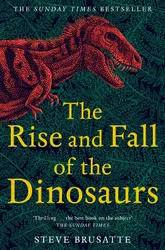Dinosaurs are a topic of endless fascination to me, and to many other people. To feed our fascination, there have been many movies, books and television series about dinosaurs. It’s still so strange to imagine that these huge creatures stomped around the landscape, some of them terrifying monsters from our nightmares, and yet they were absolutely real. When I was in primary school, around the age of 5, we learned about the dinosaurs in class, and many children today still learn about the dinosaurs in this way. Back when I was in school, in the 1980s, it was not widely understood that modern day birds had descended from dinosaurs, and that the Chicxulub crater in Mexico was the site of the asteroid impact that caused their extinction. So I was keen to read this thorough book about the dinosaurs to fill in the gaps in my knowledge.
The book is written by a paleontologist who has discovered and studied many dinosaur fossils, and it tackles the subject in roughly chronological order, from the early Triassic to the late Cretaceous. As well as describing what we know about the dinosaurs, the book covers in detail the fossil finds and other evidence that have allowed us to build up that knowledge. It also includes profiles of some of the dinosaur hunters, paleontologists, and other scientists who have explored the evidence left behind by the dinosaurs.
I was surprised to learn that many of the creatures that we call dinosaurs were not, technically speaking, actually dinosaurs. There is a technical definition, involving the earliest common ancestor of the Iguanodon and Megalosaurus. So quite a few of the creatures around at the time of the dinosaurs were from other clades. This book does cover these creatures to some extent, especially in relation to how they competed with dinosaurs.
I was pleased to find that (probably) the most famous dinosaur, and the biggest predator that has ever lived (unless we find a bigger one, perhaps!), Tyrannosaurus Rex, gets extensive coverage in its own chapter. There are lots of pictures in this book. Each chapter begins with a detailed sketch of a relevant dinosaur, and there are many photographs of skeletons and paleontologists at work.
The book makes the case that birds are dinosaurs, rather than being descended from dinosaurs. One chapter in the book is devoted to how modern day birds evolved from other types of dinosaur, and the fossil evidence we have that this is true. The book describes how, in the late Cretaceous when the (non-bird) dinosaurs went extinct, there were already birds around that would have been pretty similar to the birds we see today. The book also makes the case that wings didn’t initially evolve for flight, and were instead perhaps for display or protection initially, and were later adapted for flight when this became useful. There is fossil evidence of birds with wings that would have been too heavy to fly. I didn’t find this argument about the wings entirely convincing, but it was an interesting idea nonetheless.
The book also extensively covers the extinction of the dinosaurs, with the prime suspect for the cause being an asteroid that struck the Earth at the end of the Cretaceous, leaving behind the Chicxulub crater. Brusatte describes how this event would have been experienced by the dinosaurs, and also the longer term effects this would have had across the globe, including the disruption of food chains, leading to many more extinctions than were caused by the asteroid directly. There are some researchers who believe that the dinosaurs were heading towards extinction anyway, and that the asteroid impact only hastened their demise. But this book makes the strong case that the dinosaurs were thriving prior to the impact, and it really was the asteroid that killed them off.
The writing in this book is clear and readable, the book as a whole is very well organised, and I liked the attention paid to how we know what we know and the key fossil discoveries. The author is also clear when he is expressing his own opinion, rather than stating well established and agreed-upon facts. I learned about several dinosaurs that I didn’t know about before. So I would recommend this book for anyone who wants to refresh their childhood knowledge of the dinosaurs.
